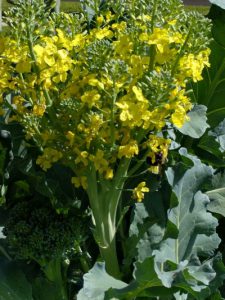It’s hot out. Sweltering. Rainy. But it’s also time to plan for cooler temperatures and relief from the daily downpour. It’s time to plan the fall garden.
In Florida, we have two vegetable planting seasons. The warm weather season starts with the last frost and runs through June. In July and August, we pull the heat-stressed plants that are magnets for pests and disease, and we let the garden rest. But by September, it’s time to plant again. A fall garden here will provide fresh produce all through the winter, to the envy of our Northern neighbors.
Heat loving plants will have a good run soon, lasting until first frost. If you haven’t started tomato, pepper, and eggplant seeds yet, check the garden center for transplants in mid- to late August. Look for seedlings that haven’t outgrown their pots. A younger healthy plant will soon outgrow a leggy root bound one. Make sure the leaves aren’t turning yellow or wilting and examine the undersides for pests. Check to see if there are multiple plants in the pot – a single uncrowded plant produces more than two that are competing for space. Pinch off any flowers or fruits as soon as you buy to ensure it has energy for growing strong roots once it’s in the ground. And one last tip – many sources encourage you to “plant deep” with tomatoes, but going too deep can suffocate the existing roots. An inch or two below the soil line to ensure a strong stem is fine.
Transplant tomatoes and peppers into the garden starting in late August.
Cool weather vegetables are so close I can almost taste the crunchy salads! Start seeds for broccoli, kale and cauliflower in September, or look for transplants in October and November. Lettuce and Swiss chard can be started in pots or seeded directly in the garden late next month. Carrots can be hard to germinate, so I like to put them between wet coffee filters for a few days, then plant them in the garden once a little root starts to show. Use half long or round types in shallow raised beds. And plant sugar snap peas directly by a trellis starting in November for harvests in January. For more options, see http://edis.ifas.ufl.edu/vh021.
Carrots come in many colors and lengths to fit any recipe and soil depth.
Edible landscaping is all the rage, and fall is a great time to plant a few attractive selections in the front yard. Scarlet kale looks like ruffled purple flowers. “Bright Lights” Swiss Chard has neon stems and makes a great edging. But broccoli is my favorite ornamental. It’s a big upright plant that can hold its own in the landscape bed. The leaves look tropical, and when I let a few of the heads bloom for the pollinators, my neighbors always ask what that beautiful plant is. Plus, the leaves are edible – if a head isn’t ready to cut, throw a few leaves in your stir-fry for broccoli flavor.
 Let a broccoli head flower for the pollinators. The big leaves are edible, too.
Let a broccoli head flower for the pollinators. The big leaves are edible, too.
Like spring vegetables, cool season veggies like full sun. I know someone who went on vacation for a week and accidentally parked her car where it would shade one of her broccoli plants. When she returned, the poor plant was already much smaller than its unshaded neighbor. Remember, these plants take full summer sun up north, so our shorter winter days are perfect for them.
Never fear, the heat will break soon – and with a little prep now, you’ll be ready to ensure a bountiful fall harvest.
This blog post was written by UF IFAS Extension Orange County Master Gardener, Mary Ann Pigora, class of 2017. The UF IFAS Extension Orange County Master Gardener Volunteers play a crucial role in the outreach of UF IFAS Extension.
 0
0


